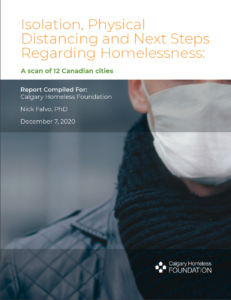Isolation, Physical Distancing and Next Steps Regarding Homelessness: A Scan of 12 Canadian Cities
Guest Blog By: Nick Falvo, PhD
During the COVID-19 pandemic, officials in Canada’s major cities have partnered with health officials and others to create more physical distancing for persons experiencing homelessness. In a recent report (available here) I provide an overview of what this has looked like in the following cities: Toronto; Montreal; Vancouver; Calgary; Edmonton; Ottawa; Winnipeg; Quebec City; Hamilton; Regina; Saskatoon; and St. John’s.
Here are 10 things to know
1. The report was commissioned by the Calgary Homeless Foundation (CHF).
As the System Planner for Calgary’s Homeless-Serving System of Care, CHF was interested in scanning what homelessness officials in other cities were doing during this unprecedented time. While the report was initially intended for internal use, CHF decided to release it publicly so that homelessness officials, researchers and advocates in other cities could learn more about the national picture.
2. Homelessness officials in Canada’s major cities have created more physical distancing through a variety of measures.
They have created more physical distancing at existing shelters, opened new facilities, and created space for both isolation and quarantine. Toronto and Vancouver are noteworthy in that both cities have secured large numbers of hotel rooms.
3. Officials in most of Canada’s large cities have continued to move persons directly from emergency shelters into permanent housing.
They have also developed innovations. For example, several cities have developed new models of moving people from homelessness into permanent housing. The report discusses these in detail.
4. Networks of cooperation have generally improved during this crisis; this is especially true with health officials.
In several cases, local health officials were perceived to have not been very engaged in homelessness prior to the pandemic, but improved their approach during the pandemic. It is hoped that these improved forms of collaboration will continue.
5. Many homelessness officials have expressed frustration with the lack of cooperation from the corrections sector.
The report finds officials in correctional facilities commonly discharge inmates without housing plans and without reaching out to homelessness officials to coordinate a transition into emergency shelter (however, Quebec City is an important exception here).
6. Across Canada, a surprisingly large number of newly-created spaces for persons experiencing homelessness are staying open (or re-locating).
Put differently, the new physical distancing arrangements put in place during the pandemic appear to be having a remarkable amount of staying power. The state of this ‘new normal’ will vary by city, however. For example, most emergency shelters in Calgary and Edmonton do not expect to be able to comply with a two-metre requirement.
7. Challenges remain in the sector.
While the current situation varies across Canada, the following challenges remain in the sector as a whole: outdoor sleeping; shared bathrooms and other common areas (as well as the additional costs of cleaning associated with these shared spaces); and new homelessness created by the economic downturn.[1]
8. Canada’s federal government has made important new funding announcements since the start of the pandemic.
The Government of Canada announced $157.5 million in one-time funding for Reaching Home in March 2020 (Reaching Home is the federal government’s main funding vehicle for homelessness). Further, in September 2020, the Government of Canada announced an additional $236.7 million for Reaching Home, along with $1 billion for modular housing, the acquisition of land, and the conversion of existing buildings into affordable housing.
9. However, all of these funding enhancements are temporary.
There has been no enhancement to permanent federal homelessness funding announced since the start of the pandemic. An enhancement to permanent funding could: support local officials in maintaining the improved physical distancing; assist in transitioning more people from both emergency shelters and outdoor encampments into permanent housing; and help pay for increased cleaning costs and staffing needs associated with the ‘new normal’ discussed above.
10. The report recommends the enhancement of the Canada Housing Benefit (CHB).
Central to the National Housing Strategy is the recent launch of the CHB, providing financial assistance to help low-income households afford their rent. It is expected that half of this money will come from the federal government, and the other half from provinces and territories. The CHB was supposed to launch nationally on 1 April 2020; however, just five provinces have formally agreed to terms on the new benefit. The federal government could increase the value of this benefit, which could encourage provinces and territories to sign on. For example, the federal government might offer 2/3 or 3/4 cost-sharing.
In sum: Homelessness officials across Canada have worked hard to improve physical distancing during the pandemic. Permanent increases in federal funding would help them both maintain this ‘new normal’ and find more permanent, affordable housing for persons experiencing homelessness.
I wish to thank Susan Falvo for assistance with this blog post.
[1] I have recently written another report about new homelessness created by the downturn. That report, commissioned by Employment and Social Development Canada, will be released in December 2020.

